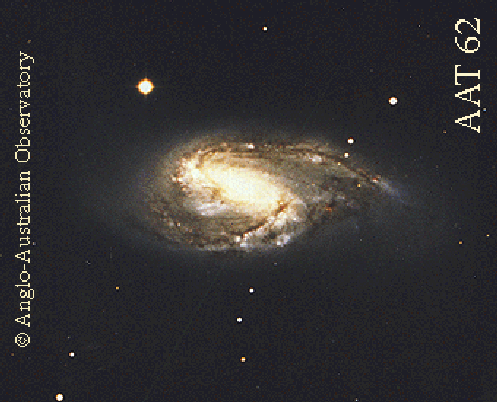Astronomy Picture of the Day
Discover the cosmos!
Each day a different image or photograph of our fascinating universe is
featured, along with a brief explanation written by a professional
astronomer.
August 10, 1996

Unusual Spiral Galaxy M66
Credit:
Anglo-Australian Telescope
photograph by David Malin
Copyright:
Anglo-Australian Telescope
Board
Explanation:
Spiral galaxy M66 is largest galaxy in the a group known as the Leo
Triplet.
M66
is somewhat peculiar because of its asymmetric spiral arms.
Usually dense waves of gas, dust, and newly formed stars - called spiral
density waves - circle
a galactic center and create a
symmetric galaxy. Gravity from nearby
Leo
Triplet neighbor M65, however, has probably distorted this galaxy. In M66,
intricate long dust lanes are seen intertwined with the bright stars that
light up the spiral arms.
Recent research indicates that
M66
is unusual in that older stars are thought to heat up the
dust in the
galaxy's
central bulge - a job attributed to
young and hot stars in many other galaxies.
M66 is famous for a powerful
"Type Ia" supernova that was observed in 1989. Stellar explosions like
this are thought nearly identical and so by noting how bright they appear,
astronomers can estimate their true distance - and therefore calibrate the
scale of the universe!
Tomorrow's picture: The Snake Nebula in Ophiuchus
| Archive
| Index
| Search
| Glossary
| Education
| About APOD |




Authors & editors:
Robert Nemiroff
(MTU) &
Jerry
Bonnell (USRA).
NASA Technical Rep.:
Sherri
Calvo.
Specific rights apply.
A service of:
LHEA
at
NASA/
GSFC




